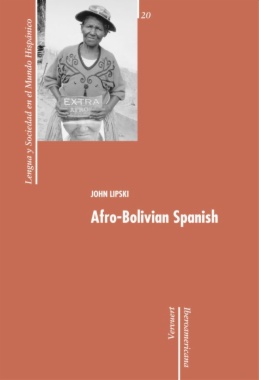Based on extensive fieldwork in the Afro-Bolivian communities, this book provides a detailed description of this unique and fascinating Afro-Bolivian dialect.
- TABLE OF CONTENTS
- List of photos, figures and maps���������������������������������������
- List of tables and charts��������������������������������
- Acknowledgements�����������������������
- Chapter 1: Afro-Bolivians and their language���������������������������������������������������
- 1.1. Introduction������������������������
- 1.2. Bolivia’s afrodescendientes and their environment�������������������������������������������������������������
- 1.3. Life in the Yungas������������������������������
- 1.4. Afro-Bolivian communities in the Yungas���������������������������������������������������
- 1.5. Demographic profile: how many Afro-Bolivians are there?�������������������������������������������������������������������
- 1.6. Afro-Bolivians’ arrival in the Yungas�������������������������������������������������
- 1.7. National awareness of Afro-Bolivians������������������������������������������������
- 1.8. Who speaks Afro-Yungueño Spanish?���������������������������������������������
- 1.9. Why has Afro-Bolivian Spanish survived?���������������������������������������������������
- 1.10. Afro-Bolivian “folk revival” and its implications for language usage���������������������������������������������������������������������������������
- 1.11. Previous publications about Afro-Bolivians and their language��������������������������������������������������������������������������
- 1.12. Early Afro-Bolivian literary examples��������������������������������������������������
- 1.13. Afro-Bolivian literary representations in the 20th century�����������������������������������������������������������������������
- 1.14. Data collection for the present study��������������������������������������������������
- Chapter 2: Phonetics and phonology�����������������������������������������
- 2.1. The phonetics of Afro-Yungueño Spanish��������������������������������������������������
- 2.2. Phonetic overview of highland Bolivian Spanish����������������������������������������������������������
- 2.3. Detailed phonetic traits of highland Bolivian Spanish�����������������������������������������������������������������
- 2.4. Phonetic characteristics of Afro-Yungueño Spanish�������������������������������������������������������������
- Chapter 3: The noun phrase���������������������������������
- 3.1. The Afro-Yungueño noun phrase�����������������������������������������
- 3.2. Indefinite articles�������������������������������
- 3.3. Definite articles�����������������������������
- 3.4. Null definite articles����������������������������������
- 3.5. Demonstratives��������������������������
- 3.6. Possessives�����������������������
- 3.7. Indefinite and negative pronouns and adjectives�����������������������������������������������������������
- 3.8. Suspension of gender agreement; masculine gender prevails���������������������������������������������������������������������
- 3.9. Invariant plurals in Afro-Bolivian Spanish������������������������������������������������������
- 3.10. “Stripped plural” noun phrases�������������������������������������������
- 3.11. Subject pronouns�����������������������������
- 3.12. Use of overt subject pronouns������������������������������������������
- 3.13. Object clitics���������������������������
- 3.14. Syntax of object clitics�������������������������������������
- Chapter 4: The Afro-Bolivian verb phrase�����������������������������������������������
- 4.1. Introduction������������������������
- 4.2. Invariant verb forms: the 3rd person singular���������������������������������������������������������
- 4.3. Verb tenses in Afro-Bolivian speech�����������������������������������������������
- 4.4. Possible restructuring to an aspect-based verbal system�������������������������������������������������������������������
- 4.5. The infinitive in Afro-Bolivian Spanish���������������������������������������������������
- 4.6. Gerunds and progressive forms�����������������������������������������
- 4.7. Past participles����������������������������
- 4.8. Combinations of ta + INFINITIVE�������������������������������������������
- 4.9. Possible use of ya as perfective particle�����������������������������������������������������
- 4.10. Possible use of va as future / irrealis particle�������������������������������������������������������������
- 4.11. Summary: particles in Afro-Bolivian Spanish?���������������������������������������������������������
- 4.12. Copulative constructions�������������������������������������
- 4.13. Existence and possession�������������������������������������
- Chapter 5: Phrase-level grammatical constructions��������������������������������������������������������
- 5.1. Phrase-level grammatical constructions��������������������������������������������������
- 5.2. Prepositions������������������������
- 5.3. Questions and interrogative forms���������������������������������������������
- 5.4. Negative particles and negative constructions���������������������������������������������������������
- 5.5. Coordinate conjunctions and conjoined clauses���������������������������������������������������������
- 5.6. Complex sentence structure��������������������������������������
- 5.7. Reduplication as intensification��������������������������������������������
- 5.8. Word order of major constituents in traditional Afro-Spanish������������������������������������������������������������������������
- Chapter 6: The Afro-Bolivian lexicon�������������������������������������������
- 6.1. Introduction������������������������
- 6.2. Lexical items derived from Spanish����������������������������������������������
- 6.3. Lexical items derived from Aymara���������������������������������������������
- 6.4. Lexical items of uncertain origin���������������������������������������������
- Chapter 7: Aymara influence in Afro-Bolivian Spanish�����������������������������������������������������������
- 7.1. Aymara and Aymara-influenced Spanish in contact with Afro-Yungueño Spanish��������������������������������������������������������������������������������������
- 7.2. Aymara and Aymara-influenced lexical elements in Afro-Yungueño Spanish����������������������������������������������������������������������������������
- 7.2.1. The filler element jay������������������������������������
- 7.2.2. Tío and tía�������������������������
- 7.2.3. Awicha��������������������
- 7.2.4. Cho�����������������
- 7.2.5. asti������������������
- 7.2.6. Other Aymara lexical items����������������������������������������
- 7.3. Aymara-Spanish phonetics vs. Afro-Bolivian phonetics����������������������������������������������������������������
- 7.4. Morphosyntax: Aymara-influenced Spanish as a possible locus of transmission���������������������������������������������������������������������������������������
- 7.4.1. Nominal and verbal morphology�������������������������������������������
- 7.4.2. Lack of noun-adjective gender agreement�����������������������������������������������������
- 7.4.3. Double possessives��������������������������������
- 7.4.4. Object-Verb word order������������������������������������
- 7.4.5. Elision of definite articles������������������������������������������
- 7.5. Summary�������������������
- Chapter 8: The status of Afro-Bolivian Spanish�����������������������������������������������������
- 8.1. Introduction������������������������
- 8.2. Is Afro-Yungueño Spanish an Afro-Hispanic (post-bozal) survival?����������������������������������������������������������������������������
- 8.3. Is Afro-Yungueño Spanish a creole language?�������������������������������������������������������
- 8.4. Implicational relationships in Afro-Yungueño Spanish: possible decreolization�����������������������������������������������������������������������������������������
- 8.5. Gender and number agreement in noun phrases: gradual decreolization?��������������������������������������������������������������������������������
- 8.6. The Afro-Yungueño verb phrase: in the footsteps of decreolization�����������������������������������������������������������������������������
- 8.7. Further discussion: but is it really decreolization?����������������������������������������������������������������
- 8.8. The importance of Afro-Yungueño Spanish to Afro-Hispanic linguistics��������������������������������������������������������������������������������
- Appendix: Sample transcriptions of Afro-Bolivian Spanish���������������������������������������������������������������
- Sample 1: Mururata, male speaker in his early 50’s���������������������������������������������������������
- Sample 2: Mururata, female speaker in her late 40’s����������������������������������������������������������
- Sample 3: Chijchipa, female speaker in her late 60’s (J), with female speaker from Mururata, late 40’s (A)�����������������������������������������������������������������������������������������������������������������
- Sample 4: Male speaker from Mururata, in his late 50’s, describes the last black king, Rey Bonifacio Pinedo������������������������������������������������������������������������������������������������������������������
- Sample 5: Female speaker from Santa Bárbara (now living in Coroico), in her early 70’s���������������������������������������������������������������������������������������������
- Sample 6: Female speaker from Chijchipa (now living in Coroico), in her early 40’s�����������������������������������������������������������������������������������������
- Sample 7: Male speaker from Chijchipa (now living in Coroico), in his late 70’s��������������������������������������������������������������������������������������
- Sample 8: Male speaker from Dorado Chico (now living in La Paz), in his mid 50’s���������������������������������������������������������������������������������������
- Bibliography�������������������

